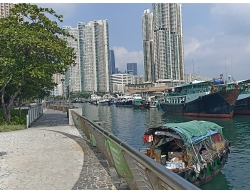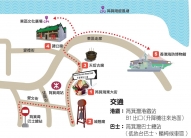Home
> Cultural Discovery Line
> Shau Kei Wan

Shau Kei Wan
Barrier-free Index★☆☆☆☆
Shau Kei Wan, one of the earliest-developed areas in Hong Kong, got its name from its sieve-like gulf contour. Residents there made a living from the fishery in the past. Thanks to the large-scale development by the government, the Island Line and Island Eastern Corridor were completed, which improved transportation. The fishery back then contributed to the establishment of several ancient temples in Shau Kei Wan, which are still teeming with worshipers even today.

Enlarge map
Traffic
|
MTR
Bus |
Exit B1 (lift to/from the ground)
Low-floor bus, wheelchair waiting area |


Shau Kei Wan Main Street East
![]()
Shau Kei Wan Main Street East was the centre of the Eastern District in the early years, along which stood residences and shops. As a hub of traditional bing sutts (a type of traditional cold drinking house), street food and tasty food from all over the world, Shau Kei Wan Main Street East has attracted numerous people from outside the area. There is a century-old banyan tree in the centre of Shau Kei Wan Main Street East. Shau Kei Wan Main Street East remains a famous food street to this day, on which there are more than 60 restaurants. It is an ideal destination for foodies, where they can try gai daan jai (egg waffle), jyu daan fan (fish balls with rice noodles), and wun zai ci (shark fin soup).
| Easy-to-Reach Index: | |||
| Barrier Free Index: | |||
| Recommendation Index: |
Tour Time: Approx 30 minutes |

Short comments: There is a step outside most restaurants on Shau Kei Wan Main Street East, which is difficult for wheelchair users to access. The Federation recommends such restaurants provide mobile ramps to facilitate access where space permits.
Hint: Most restaurants on Shau Kei Wan Main Street East open in the afternoon, and only a few in the morning.
Address: Shau Kei Wan Main Street East
Shing Wong Temple
![]()
![]()
Built in 1877 (the third year of the Guangxu era of the Qing dynasty), Shing Wong Temple was formerly known as Fuk Tak Temple (Soil-Ground God Temple), in which, aside from Shing Wong (City God), Tai Sui, ten kings, five deities, and the Soil-Ground God are worshiped. It was renovated multiple times and was extended into the Shing Wong Temple in 1973.
| Easy-to-Reach Index: | |||
| Barrier Free Index: | |||
| Recommendation Index: |
Tour Time: Approx 15 minutes |

Short comments: The two iron pillars at the entrance to the Shing Wong Temple can be removed as they make it inconvenient for wheelchair users to enter and exit the temple. There is a public restroom with accessible toilets across the road. Next to the temple, there are parking spaces designated for the disabled, enabling them to drive to the temple. On the way, they can also have a meal on Shau Kei Wan Main Street East.

Address: At the intersection of Shau Kei Wan Main Street East with Kam Wa Street
Tin Hau Temple
The Tin Hau Temple in Shau Kei Wan was built in the Tongzhi era of the Qing dynasty. It has been rehabilitated several times. Cultural relics of great historical value are preserved in the temple, including a century-old bell, wall paintings and pottery. Many worshipers formally visit the Tin Hau Temple at the Kwun Yum Treasury Opening Festival every year.
| Easy-to-Reach Index: | |||
| Barrier Free Index: | |||
| Recommendation Index: |
Tour Time: Approx 15 minutes |

Short comments: To reach the Tin Hau Temple, visitors must ascend several stairs, which are painted yellow, so that the visually impaired people can identify the location of the stairs.

Address: 53 Shau Kei Wan Main Street East, Shau Kei Wan
Tam Kung Temple
![]()
![]()
It is said that Tam Kung was called Tam Tak and became an immortal in heaven at the age of 13. He was deified by fishermen for his capability of controlling the forces of nature, especially by fishermen in Guangdong Province, who built temples to worship him. In the early years of Hong Kong's opening up, many stonemasons in Huizhou were drawn to Hong Kong by its huge demand for stones. In the process, the belief in Tam Kung was introduced into Hong Kong, as a result of which, a number of Tam Kung temples were built, with the Tam Kung Temple in Shau Kei Wan being the oldest.
Built in the 31st year of the Guangxu era of the Qing dynasty (1905), the Tam Kung Temple in Shau Kei Wan has a history of more than a century. It has been rehabilitated several times and holds a large number of cultural relics, such as plaques, bronze bells, and drums from the Qing dynasty. It is said that the megalith in front of the temple is Tam Kung's seal, which is more than a hundred years old. A parade is organized by the Tam Kung Temple every year to celebrate the Tam Kung Festive on the 8th day of the 4th lunar month, attracting a large number of visitors.
| Easy-to-Reach Index: | |||
| Barrier Free Index: | |||
| Recommendation Index: |
Tour Time: Approx 30 minutes |

Short comments: A parking space is designed for the disabled on the parking lot outside the Tam Kung Temple, enabling disabled people to drive to the temple. Besides, if they need to use the restroom, they may go to the accessible toilets on the Aldrich Bay Promenade across the temple.
Address: Shau Kei Wan Tam Kung Temple Road
Check Point 1 Eastern District Cultural Square
![]()
![]()
Opening in early 2019, the Eastern District Cultural Square is a major residence project of the Eastern District. It is located at the intersection of Shau Kei Wan Tam Kung Temple Road with Tung Hei Road and borders the Aldrich Bay Promenade and Shau Kei Wan Station (MTR). There is a covered main stage, a piazza and a small stage adjacent to the waterfront on the cultural square. Besides, the cultural square holds an audience of more than 600 people, and the green area exceeds 2,000 square metres.


Short comments: The cultural square is next to the Aldrich Bay Promenade, which is equipped with accessible toilets, so it is a good destination for wheelchair users to visit.

Check Point 2 Shau Kei Wan Typhoon Shelter
![]()
![]()
Visitors may enjoy the view of the Shau Kei Wan Typhoon Shelter in the park after visiting the Tam Kung Temple and Eastern District Cultural Square.
Hong Kong Museum of Coastal Defence
![]()
Hong Kong Museum of Coastal Defence is converted from the Old Lei Yue Mun Fort with a history of more than one hundred years. It was used to defend against the Japanese invaders during World War II. The Lyemun Fort was converted into the British military training base after World War II and into the Hong Kong Museum of Coastal Defence after the withdrawal of the British army.
The military facilities of the Lyemun Fort are preserved in the museum, including the torpedo tube and ammunition dump. Visitors may visit the museum along the converted historical trail. The museum holds more than 400 exhibits that are related to Hong Kong's defence history. Besides, permanent exhibitions are organized to introduce Hong Kong's coastal defines history of more than six hundred years.
Tour time: Approx. two to three hours
Bus Routes via the Hong Kong Museum of Coastal Defence
| Route No. | Origin and destination | Alighting stop |
| NWFB 82X | Quarry Bay to Siu Sai Wan Island Resort (to Siu Sai Wan only) | Hong Kong Museum of Coastal Defence Station |
| Citybus 85 | Braemar Hill to Siu Sai Wan | Hong Kong Museum of Coastal Defence Station |
| Siu Sai Wan to Braemar Hill | A Kung Ngam Village Road |
Info
Tel.: 2569 1500
Website: www.lcsd.gov.hk/CE/Museum/Coastal
Address: 175 to 177 Tung Hei Road, Shau Kei Wan
Parking Spaces Designated for the Disabled
| Shau Kei Wan Main Street East | Shau Kei Wan Kam Wa Street (near Main Street East) x 1 | ||
| Shau Kei Wan Kam Wa Street (near Wang Wa Street) x 1 | |||
| Shing Wong Temple |
Shau Kei Wan Kam Wa Street (near Main Street East) x 1 | ||
| Shau Kei Wan Kam Wa Street (near Wang Wa Street) x 1 | |||
| Tam Kung Temple | Tung Hei Road Parking Lot of the Tam Kung Temple (under the Island Eastern Corridor) x 1 | ||
| Eastern District Cultural Square | Tung Hei Road Parking Lot of the Tam Kung Temple (under the Island Eastern Corridor) x 1 |







